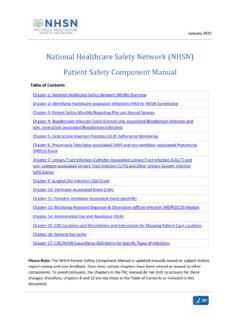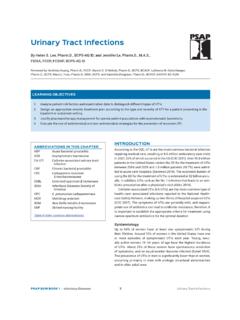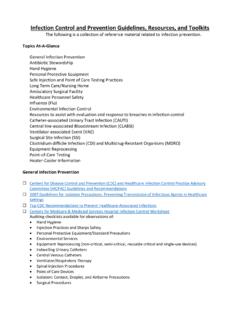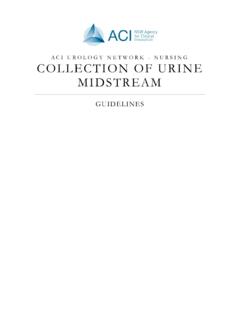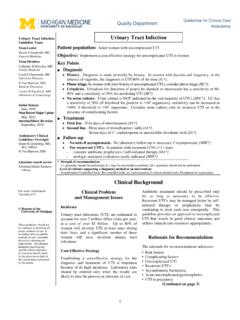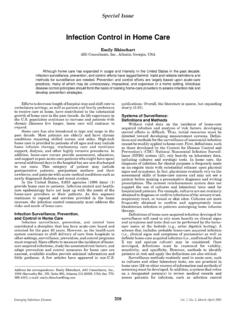Transcription of CMS Manual System
1 CMS Manual System Department of Health & Human Services (DHHS)Pub. 100-03 Medicare National Coverage Determinations Centers for Medicare & Medicaid Services (CMS)Transmittal 17 Date: JULY 2, 2004 CHANGE REQUEST 2130 I. SUMMARY OF CHANGES: This transmittal manualizes the 23 laboratory negotiated rulemaking national coverage determinations (NCDs). These NCDs are currently contained in PM AB-02-110 and have been converted to the NCD Manual without change to the narrative. Coding guidance contained in the PM is not being manualized but is available in the NCD Coding Manual on the Internet at MANUALIZATION EFFECTIVE DATE: Not Applicable IMPLEMENTATION DATE: Not Applicable Disclaimer for Manual changes only: The revision date and transmittal number apply to the red italicized material only. Any other material was previously published and remains unchanged. However, if this revision contains a table of contents, you will receive the new/revised information only, and not the entire table of contents.
2 II. CHANGES IN Manual INSTRUCTIONS: (R = REVISED, N = NEW, D = DELETED) R/N/D CHAPTER/SECTION/SUBSECTION/TITLE N 1 Culture, Bacterial N 1 Immunodeficiency Virus (HIV) Testing (Prognosis Including Monitoring) N 1 Immunodeficiency Virus (HIV) Testing (Diagnosis) N 1 Counts N 1 Thromboplastin Time (PTT N 1 Time (PT) N 1 Iron Studies N 1 Crosslinks, Any Method N 1 Glucose Testing N 1 Hemoglobin/Glycated Protein N 1 Testing N 1 Testing N 1 Therapeutic Drug Assay N 1 N 1 Antigen N 1 Chorionic Gonadotropin N 1 Antigen by Immunoassay CA 125 N 1 Antigen by Immunoassay CA 15-3/CA N 1 Antigen by Immunoassay CA 19-9 N 1 Specific Antigen N 1 Glutamyl Transferase N 1 Panel/Acute Hepatitis Panel N 1 Occult Blood Test *III. FUNDING: These instructions shall be implemented within your current operating budget. IV. ATTACHMENTS: X Business Requirements X Manual Instruction Confidential Requirements One-Time Notification Recurring Update Notification *Medicare contractors only Attachment - Business Requirements Pub.)
3 100-03 Transmittal: 17 Date: July 2, 2004 Change Request 2130 SUBJECT: Manualization of the Negotiated Clinical Diagnostic Laboratory National Coverage Determinations I. GENERAL INFORMATION A. Background: On November 23, 2001, CMS published a final rule (66 FR 58788) on coverage and administrative policies for clinical diagnostic laboratory services. The rule included an addendum that contained 23 national coverage determinations (NCDs) that had been developed under negotiated rulemaking. We implemented these NCDs through Program Memorandum AB 02-110, which became effective November 25, 2002. B. Policy: By way of this CR, we are manualizing the 23 negotiated laboratory NCDs into publication 100-03, the National Coverage Determination Manual . The narrative of the NCDs is being manualized unchanged. The coding guidelines that are associated with these NCDs is available in the NCD Coding Manual , which is published quarterly on the Internet at Since this policy has been implemented for nearly 2 years, no action on the part of the contractors is required at this time.
4 C. Provider Education: None. II. BUSINESS REQUIREMENTS Shall" denotes a mandatory requirement "Should" denotes an optional requirement Requirement # Requirements Responsibility N/A III. SUPPORTING INFORMATION AND POSSIBLE DESIGN CONSIDERATIONS A. Other Instructions: N/A X-Ref Requirement # Instructions B. Design Considerations: N/A X-Ref Requirement # Recommendation for Medicare System Requirements C. Interfaces: N/A D. Contractor Financial Reporting /Workload Impact: N/A E. Dependencies: N/A F. Testing Considerations: N/A IV. SCHEDULE, CONTACTS, AND FUNDING Effective Date: Not Applicable Implementation Date: Not Applicable Pre-Implementation Contact(s): Jackie Sheridan-Moore 410-786-4635 Post-Implementation Contact(s): Jackie Sheridan-Moore 410-786-4635 These instructions shall be implemented within your current operating budget. Medicare National Coverage Determinations Manual Chapter 1 - Coverage Determinations Sections 160 thru 200 _____ Table of Contents (Rev.)
5 17, Issued: 07-02-04) (Effective/Implementation: Not Applicable) Urine Culture, Bacterial Human Immunodeficiency Virus (HIV) Testing (Prognosis Including Monitoring) Human Immunodeficiency Virus (HIV) Testing (Diagnosis) Blood Counts Partial Thromboplastin Time (PTT) - Prothrombin Time (PT) Serum Iron Studies Collagen Crosslinks, Any Method Blood Glucose Testing Glycated Hemoglobin/Glycated Protein - Thyroid Testing Lipid Testing Digoxin Therapeutic Drug Assay - Alpha-fetoprotein Carcinoembryonic Antigen Human Chorionic Gonadotropin Tumor Antigen by Immunoassay CA 125 Tumor Antigen by Immunoassay CA 15-3/CA Tumor Antigen by Immunoassay CA 19-9 Prostate Specific Antigen Gamma Glutamyl Transferase Hepatitis Panel/Acute Hepatitis Panel Fecal Occult Blood Test - Urine Culture, Bacterial (Rev. 17, Issued: 07-02-04) (Effective/Implementation: Not Applicable) PM AB-02-110 A bacterial urine culture is a laboratory procedure performed on a urine specimen to establish the probable etiology of a presumed urinary tract infection.
6 It is common practice to do a urinalysis prior to a urine culture. A urine culture may also be used as part of the evaluation and management of another related condition. The procedure includes aerobic agar-based isolation of bacteria or other cultivable organisms present, and quantitation of types present based on morphologic criteria. Isolates deemed significant may be subjected to additional identification and susceptibility procedures as requested by the ordering physician. The physician s request may be through clearly documented and communicated laboratory protocols. Indications 1. A patient s urinalysis is abnormal suggesting urinary tract infection, for example abnormal microscopic (hematuria, pyuria, bacteriuria); abnormal biochemical urinalysis (positive leukocyte esterase, nitrite, protein, blood); a Gram s stain positive for microorganisms; positive bacteriuria screen by a non-culture technique; or other significant abnormality of a urinalysis.
7 While it is not essential to evaluate a urine specimen by one of these methods before a urine culture is performed, certain clinical presentations with highly suggestive signs and symptoms may lend themselves to an antecedent urinalysis procedure where follow-up culture depends upon an initial positive or abnormal test result. 2. A patient has clinical signs and symptoms indicative of a possible urinary tract infection (UTI). Acute lower UTI may present with urgency, frequency, nocturia, dysuria, discharge or incontinence. These findings may also be noted in upper UTI with additional systemic symptoms (for example, fever, chills, lethargy); or pain in the costovertebral, abdominal, or pelvic areas. Signs and symptoms may overlap considerably with other inflammatory conditions of the genitourinary tract (for example, prostatitis, urethritis, vaginitis, or cervicitis). Elderly or immunocompromised patients, or patients with neurologic disorders may present atypically (for example, general debility, acute mental status changes, declining functional status).
8 3. The patient is being evaluated for suspected urosepsis, fever of unknown origin, or other systemic manifestations of infection but without a know source. Signs and symptoms used to define sepsis have been well established. 4. A test-of-cure is generally not indicated in an uncomplicated infection. However, it may be indicated if the patient is being evaluated for response to therapy and there is a complicating co-existing urinary abnormality including structural or functional abnormalities, calculi, foreign bodies, or ureteral/renal stents or there is clinical or laboratory evidence of failure to respond as described in Indications 1 and 2. 5. In surgical procedures involving major manipulations of the genitourinary tract , preoperative examination to detect occult infection may be indicated in selected cases (for example, prior to renal transplantation, manipulation or removal of kidney stones, or transurethral surgery of the bladder of prostate).
9 6. Urine culture may be indicated to detect occult infection in renal transplantation recipients on immunosuppressive therapy. Limitations 1. CPT 87086 may be used one time per encounter. 2. Colony count restrictions on coverage of CPT 87088 do not apply as they may be highly variable according to syndrome or other clinical circumstances (for example, antecedent therapy, collection time, degree of hydration). 3. CPT 87088, 87184, and 87186 may be used multiple times in association with or independent of 87086, as urinary tract infections may be polymicrobial. 4. Testing for asymptomatic bacteriuria as part of a prenatal evaluation may be medically appropriate but is considered screening and therefore not covered by Medicare. The Preventive Services Task Force has concluded that screening for asymptomatic bacteriuria outside of the narrow indication for pregnant women is generally not indicated. There are insufficient data to recommend screening in ambulatory elderly patients including those with diabetes.
10 Testing may be clinically indicated on other grounds including likelihood of recurrence or potential adverse effects of antibiotics, but is considered screening in the absence of clinical or laboratory evidence of infection. - Human Immunodeficiency Virus (HIV) Testing (Prognosis Including Monitoring) (Rev. 17, Issued: 07-02-04) (Effective/Implementation: Not Applicable) PM AB-02-110 HIV quantification is achieved through the use of a number of different assays, which measure the amount of circulating viral RNA. Assays vary both in methods used to detect viral RNA as well as in ability to detect viral levels at lower limits. However, all employ some type of nucleic acid amplification technique to enhance sensitivity, and results are expressed as the HIV copy number. Quantification assays of HIV plasma RNA are used prognostically to assess relative risk for disease progression and predict time to death, as well as to assess efficacy of antiretroviral therapies over time.










